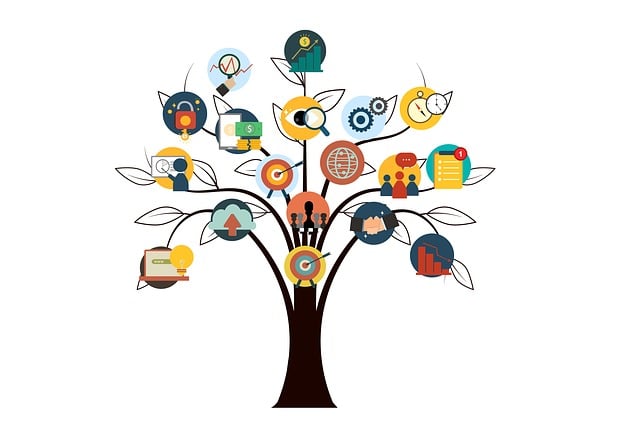Implementing a Business Info Schema organizes raw data into structured business information, enhancing online presence and search engine comprehension. This includes Logo Markup for brand recognition, About Us Schema for key details, Organization JSON-LD for comprehensive knowledge graphs, and Contact Info Schema for critical data access. Correct entity type classification improves brand visibility, simplifies complex info, and creates engaging knowledge panels. Regular updates ensure dynamic online presence and boost user experience, professionalism, and reliability in a competitive market.
In today’s data-driven landscape, organized and structured knowledge is key to unlocking your organization’s full potential. Implementing a robust Business Info Schema serves as the cornerstone of this process. By defining entities such as people, places, and things, establishing relationships between them, and visualizing insights through knowledge panels, you gain profound brand understanding and facilitate effective decision-making. This structured approach optimizes for future growth, ensuring your organization remains agile and competitive in a dynamic market.
- Define Business Info Schema: Unlocking Structured Data
- Understand Entity Types: People, Places, Things
- Establish Relationships: Connect Data Points
- Implement Knowledge Panels: Visualize Insights
- Enhance Brand Understanding: A Holistic View
- Optimize for Future Growth: Evolving Your Schema
Define Business Info Schema: Unlocking Structured Data

Implementing a Business Info Schema is a powerful strategy to transform raw data into meaningful structured information about your organization. By defining a schema specifically tailored for business details, you unlock the potential to enrich your online presence with consistent and standardized data. This approach enables search engines to comprehend and display your company’s information more effectively. For instance, Logo Markup becomes an integral part of this structured data, ensuring that your brand identity is immediately recognizable on search engine result pages (SERPs).
The About Us Schema, a prime example of a business-focused schema, provides a structured format to share crucial organization details such as history, mission, and team information. Furthermore, leveraging Organization JSON-LD allows for the creation of comprehensive knowledge graphs, enhancing user understanding and engagement with your brand. This structured presentation not only improves accessibility but also paves the way for more effective content optimization and better brand visibility online.
Understand Entity Types: People, Places, Things

In the realm of Business Info Schema, understanding entity types is a foundational step for effective data structuring. These entities represent core elements that define any organization, and they include People, Places, and Things. People are individuals associated with the business, such as employees or founders; Places refer to physical locations where operations take place; while Things encompass products, services, or tangible assets. Correctly identifying and categorizing these entities within your Organization JSON-LD ensures a structured knowledge panel display, enhancing brand understanding across various digital platforms.
For instance, implementing the Contact Info Schema becomes seamless when entity types are clearly defined. By marking up critical information like employee names, job roles, business addresses, phone numbers, and email addresses using relevant schema types, you enable search engines to comprehend your organization’s structure better. This structured data also facilitates personalized interactions with customers by providing detailed insights into your About Us Schema, thereby fostering stronger brand connections in a highly competitive market.
Establish Relationships: Connect Data Points

Implementing a structured approach to your organization’s data is key to enhancing brand understanding and creating an engaging knowledge panel display. This involves establishing relationships between various data points within your Business Info Schema. By connecting pieces of information, you create a coherent picture that allows users to quickly grasp essential business details. For instance, linking your organization’s name with its JSON-LD markup ensures consistent branding across platforms. Similarly, integrating Logo Markup enhances visual recognition and adds a familiar touch to your online presence.
Additionally, incorporating Contact Info Schema enables potential customers or partners to access critical data instantly. This includes not just the address but also phone numbers, email addresses, and operating hours—all vital for fostering connections and facilitating seamless interactions. When these elements are seamlessly integrated, they collectively contribute to a well-organized knowledge panel, simplifying complex information and making your organization’s profile more accessible and user-friendly.
Implement Knowledge Panels: Visualize Insights

Implementing Knowledge Panels is a powerful strategy to visualize and present your business info schema, enhancing brand understanding and user experience. By leveraging structured brand data, these panels offer a concise yet comprehensive overview of your organization, making it easier for customers to navigate and discover essential details. Think of them as digital business cards or mini-sites within your website, showcasing key information in a visually appealing format.
This approach aligns perfectly with the concept of Organization JSON-LD, which provides a structured way to represent contact info schema and other relevant data. By integrating these panels, you create a seamless experience where users can quickly grasp your business’s identity, offerings, and critical points of contact. It not only simplifies complex information but also reinforces brand consistency across various digital touchpoints.
Enhance Brand Understanding: A Holistic View

Implementing a robust Business Info Schema is akin to offering your organization a comprehensive map, enabling stakeholders and customers alike to navigate your brand’s vast landscape with ease. By structuring your business information using schemas like Organization JSON-LD, you paint a holistic picture of who you are, what you do, and how you do it. This structured brand data enriches the customer experience by providing a unified view of your company across various platforms and touchpoints.
Think of it as transforming your chaotic “About Us” section into a meticulously organized symphony of details—from your mission and vision to team profiles and service offerings. The result? Enhanced brand understanding, improved search engine visibility, and a more engaging knowledge panel display that resonates with both users and algorithms.
Optimize for Future Growth: Evolving Your Schema

As your organization grows and evolves, so too should your schema – the structured data that forms the backbone of your online presence. Optimizing your Business Info Schema for future growth ensures that your brand story remains dynamic and adaptable. This involves regularly updating key elements like location details (using About Us Schema or Contact Info Schema), services offered, and organizational hierarchy. By doing so, you enable search engines to better understand your business at every stage of its development.
A robust schema also prepares your brand for emerging trends in online information consumption. For instance, incorporating structured brand data allows for enhanced knowledge panel displays that provide concise, accurate insights to users searching for your business. This not only improves user experience but also reinforces your brand’s professionalism and reliability, setting the stage for continued success and expansion.
